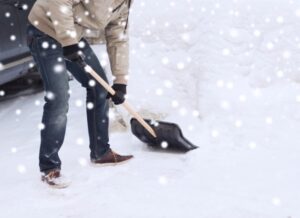Once distinct domains, the fields of fitness, wellness, and clinical healthcare are becoming increasingly intertwined…

Shoveling and Lifting Techniques For Snow Time
Overview
As the snow season sets in, the task of shoveling big piles of snow from your sidewalks and driveway begins.
Unfortunately, and despite how mundane this task may seem, many people injure themselves during shoveling due to poor technique and the involvement of the wrong muscle groups.

In this article, we will discuss the muscles that usually get injured during snow shoveling and lifting.
How to properly shovel snow
Many people get injured during snow shoveling due to poor planning and technique.
To avoid any injuries, you should follow these steps:
Warm-up before starting
Similar to other forms of exercise, shoveling snow is a serious physical activity that requires warming up your muscles and joints.
For instance, if you are just waking up, avoid shoveling until after 45–60 minutes. You see, proper snow shoveling recruits the glutes, hamstrings, quadriceps, core muscles, lower and upper back, and shoulder muscles.
Therefore, if you don’t perform any warmup routines, you will end up with sore muscles susceptible to injuries.
Pay attention to how you are holding the shovel
For starters, you need to keep a wide grip on the shovel handle, with one hand near the top of the handle and the other near the end. This allows you to gain better control over the shovel.
You will also have a mechanical advantage by keeping the weight of the load close to your body.
Take frequent breaks
The body becomes particularly prone to injuries when fatigue sets in. Therefore, try to keep the snow-shoveling intervals short and take frequent breaks whenever necessary.
For reference, you should not perform this task for more than 40 minutes at a time. If you are relatively fit, you can opt for 20–minute periods, whereas sedentary individuals can snow-shovel for 10–minute intervals.
Strength train regularly
Regular strength training gives you a fit muscular system that’s able to handle more physically demanding activities.
By building the correct muscle groups, you are less likely to get injured when snow-shoveling. You will also notice that the task is no longer exhausting, which allows you to do more work in a shorter time.
What to do if you get injured?
Like all other injuries, you first want to evaluate the severity of the trauma.
For instance, if you are experiencing absolute severe pain, swelling, and reduced range of motion, you may want to consult with a professional.
You could consider hiring a chiropractor “LIKE ME” to optimize the function of your musculoskeletal system and prevent future injuries. As a bonus, you’ll get rid of muscle stiffness and pain with the various therapies we have to offer at this office. You could see a list of our services HERE!
Takeaway message
Snow shoveling and lifting is an enjoyable task that can be a great workout if you do it the right way.
Hopefully, this article managed to shed some light on the topic of snow shoveling.
If you have any questions, concerns, or something that you want to add, please don’t hesitate to share your thoughts in the comment section below.




